|
|
|||
THIS WEEK at HILTON POND
22-31 May 2006
Installment #317---Visitor #
(Back to Preceding Week; on to Next Week)
|
ANGLEPOD:
A DIFFERENT MILKWEED AND ITS POLLINATORS The 11-acre tract that makes up Hilton Pond Center for Piedmont Natural History includes almost 2.5 miles of trails--which seems geometrically impossible until you see how those pathways twist and wind and undulate across the property to take advantage of sundry microhabitats. We try to walk a portion of our trails every day we're on-site and understandably have gotten familiar with them over the past 25 years, but due to natural succession and happenstance we frequently encounter previously unseen flora and fauna along the path. Just this week, for example, we spotted a "new" green vine twining its way up a spindly sprout of Japanese Privet that somehow had escaped the sharp blades of cutting tools with which we battle invasive plants. The vine probably had gotten started a few years previous because it seemed too robust for just this year's growth. Thus, we're guessing we simply hadn't walked this part of the trail at the precise time of year when the vine would be most obvious--especially since it was partly hidden by foliage of two other evil aliens, Vinca and Chinese Wisteria. In fact, we might not have noticed the vine even this year had it not been producing small but distinctive flowers that caught our eye--and one of our other primary senses.
All text & photos © Hilton Pond Center The four-foot-long vine, whose bright green and slightly hairy stem was about a quarter-inch in diameter, bore pairs of nearly circular six-inch leaves attached opposite each other. From each dual leaf axil (below) arose a floral stem that branched into two or three or four stalks tipped with either a gumdrop-shaped green bud or an open star-shaped flower (above). The blossom itself wasn't very large--only about three-fourths of an inch across--and its colors were less than showy: Green-tipped petals with dark purple bases and a brownish center.
When we examined the vine's flower closely we saw it had a rather unusual configuration that caused an immediate flashback to days when we taught high school biology and maintained in our classroom/lab a rather notorious plant named Star Flower (below left). Carrion Flower is one of the Stapeliads, a plant group from Africa whose odoriferous nectar mimics the stench of dead animals. As mentioned above, when we found our new flowering vine at Hilton Pond Center we immediately were reminded of the shape of blooms on those stinky Stapeliads, so our next action was logical: We leaned over to bring our nose very close to the flower on the vine along the trail. Although not as overwhelmingly nauseating as the odor from our classroom Star Flower, emanating from the vine's blossom was the unmistakable odor of something dead. No wonder the little bloom was attracting even smaller flies, such as the quarter-inch-long pale yellow one shown below.
With flower shape and a potent odor as clues, we were able to return to our Hilton Pond library armed with enough hints to look up the new-found vine in our plant taxonomy books. First, in a volume that covered plants of the world, we learned the Carrion Flower stapeliad we had maintained in our high school lab is in the Asclepiadaceae, a family that includes the North American milkweeds. Anglepod, so-called because its milkweed-like fruiting body has sharp edges (above left), grows wild in moist or swampy woods in the Southeast and west to Texas and Kansas, sometimes overlapping in range with its several congeners. Although its growth habits probably haven't changed much in the past 40 years since Radford discussed the plant, scientific understanding of milkweeds in general has evolved--so much so that the Asclepiadaceae are now lumped into the closely related Apocynaceae (Dogbane Family), along with Blue Star, Indian Hemp, and--GASP!--the very same non-native Vinca (Periwinkle) that was growing on the trail beside our vine. With a little further Web searching, we also found M. suberosa is now referred to as Gonolobus suberosus. After identifying our trailside vine we went back with camera, tripod, and close-up lens to see if we could capture images of various carrion-loving insects that might be attracted to Anglepod's flower odor. Over a few days, as the flowers matured and possibly produced more copious amounts of fragrant nectar, we saw the yellow-white fly above (possibly a Lauxaniid), an even smaller and unidentified skinny black fly with bright red eyes (above right), and a truly miniscule one-millimeter-long creature (below) that appeared to be the nymphal stage of a True Bug (perhaps a Mirid).
We weren't surprised that, as we watched, the Anglepod flowers were also visited by several different kinds of much larger Muscids--some of which resembled and could have been common House Flies. None of these stayed long enough to allow us to photograph them, but it's likely they, too, were attracted by the faint but detectable odor of carrion from Anglepod flowers. Such smells might not be very pleasant for human observers, but considering the preponderance of flies around Hilton Pond and the rest of the world it's surprising even more plants haven't developed stinky strategies for attracting those myriad dipterans as pollinators. All text & photos © Hilton Pond Center
Anglepod (above, formerly Periploca carolinensis), as drawn and engraved in 1732 by German botanist Johann Jacob Dillenius (1687-1747) Comments or questions about this week's installment?
Thanks to the following fine folks for recent gifts in support of Hilton Pond Center for Piedmont Natural History and/or Operation RubyThroat: The Hummingbird Project. Your contributions allow us to continue writing, photographing, and sharing "This Week at Hilton Pond." (See Support if you'd like to make a gift of your own.)
"This Week at Hilton Pond" is written & photographed You may wish to consult our Index of all nature topics covered since February 2000. You can also use our on-line Hilton Pond Search Engine at the bottom of this page. For a free, non-fattening, on-line subscription to |


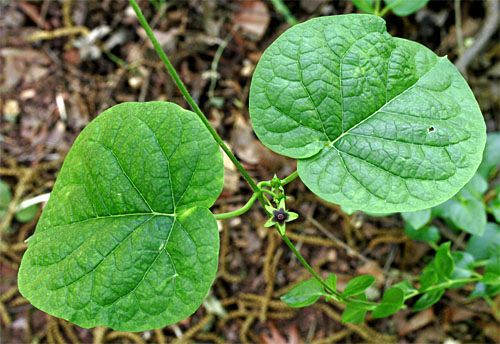
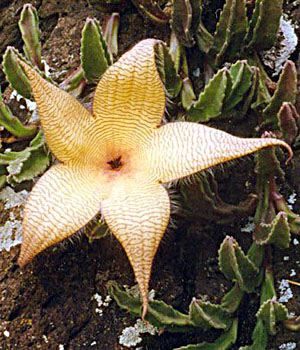 This succulent, which we kept in a clay pot on a windowsill in the back of the room, annually announced its presence by producing five mottled purple-and-brown petals on a large star-shaped blossom that was quite spectacular. Nearly ten inches across, the blossom would have attracted attention just by its curious visual appeal, but what really alerted our students to the bloom--along with most of the rest of the science wing--was its fragrance; as people often remarked when they passed the door of our lab while covering their noses with their hands, "What IS that stinking smell?" You see, this eye-pleasing "Star Flower" has an alternate name of "Carrion Flower," and with good reason: The blossom stunk like rotten meat!
This succulent, which we kept in a clay pot on a windowsill in the back of the room, annually announced its presence by producing five mottled purple-and-brown petals on a large star-shaped blossom that was quite spectacular. Nearly ten inches across, the blossom would have attracted attention just by its curious visual appeal, but what really alerted our students to the bloom--along with most of the rest of the science wing--was its fragrance; as people often remarked when they passed the door of our lab while covering their noses with their hands, "What IS that stinking smell?" You see, this eye-pleasing "Star Flower" has an alternate name of "Carrion Flower," and with good reason: The blossom stunk like rotten meat!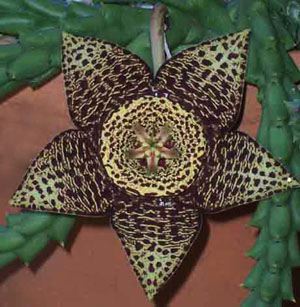 For folks accustomed to the pleasant aroma of honeysuckle and roses it may seem strange for a flower to produce "Eau de Landfill," but such odor merely demonstrates that different plants competing for different pollinators may do so in different ways. While some flowers attract insects with sweet smells, others such as Carrion Flowers--including our classroom Stapelia gigantea and the closely related S. mutabilis (above right)--produce a fragrance that brings in various dipterans (flies) and other insects more accustomed to feeding on roadkills. Some stapeliads have very complex flowers that require pollinators to enter and stay for lengthy periods, kicking and probing until pollen packets (pollinia) are released.
For folks accustomed to the pleasant aroma of honeysuckle and roses it may seem strange for a flower to produce "Eau de Landfill," but such odor merely demonstrates that different plants competing for different pollinators may do so in different ways. While some flowers attract insects with sweet smells, others such as Carrion Flowers--including our classroom Stapelia gigantea and the closely related S. mutabilis (above right)--produce a fragrance that brings in various dipterans (flies) and other insects more accustomed to feeding on roadkills. Some stapeliads have very complex flowers that require pollinators to enter and stay for lengthy periods, kicking and probing until pollen packets (pollinia) are released.
 Then we consulted our faithful old copy of Radford's Manual of the Vascular Flora of the Carolinas and started thumbing through the milkweed section. We quickly found there ARE distant relatives of stapeliads here in the Piedmont, they are vines, and they are all in genus Matelea. After that it was a relatively simple but nonetheless tedious task to narrow down the flower from our vine to M. suberosa, a native species also known as "Anglepod."
Then we consulted our faithful old copy of Radford's Manual of the Vascular Flora of the Carolinas and started thumbing through the milkweed section. We quickly found there ARE distant relatives of stapeliads here in the Piedmont, they are vines, and they are all in genus Matelea. After that it was a relatively simple but nonetheless tedious task to narrow down the flower from our vine to M. suberosa, a native species also known as "Anglepod."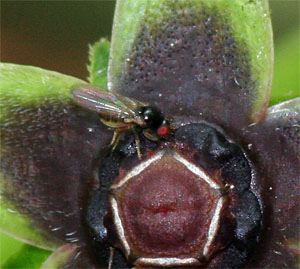 This epithet reflects the fact that early plant taxonomist Linnaeus--who created both names--had thought two different specimens of the same plant were two distinct species, when in actuality both were what he initially had called G. suberosus. Thus, Linnaeus' original name takes precedence.
This epithet reflects the fact that early plant taxonomist Linnaeus--who created both names--had thought two different specimens of the same plant were two distinct species, when in actuality both were what he initially had called G. suberosus. Thus, Linnaeus' original name takes precedence.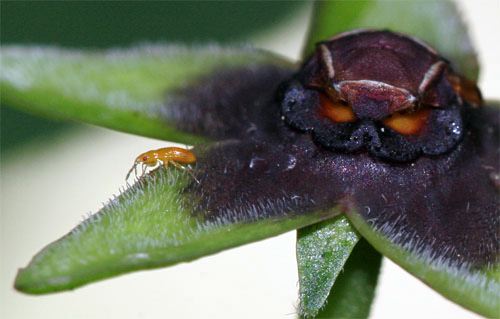
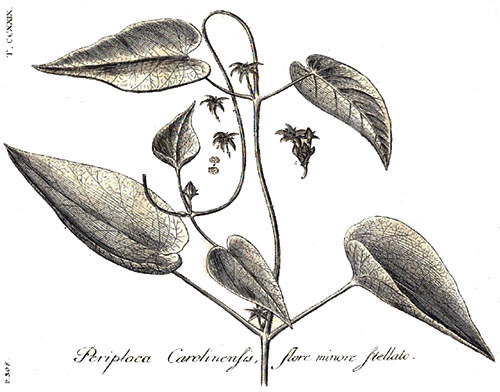


 Please report your
Please report your
